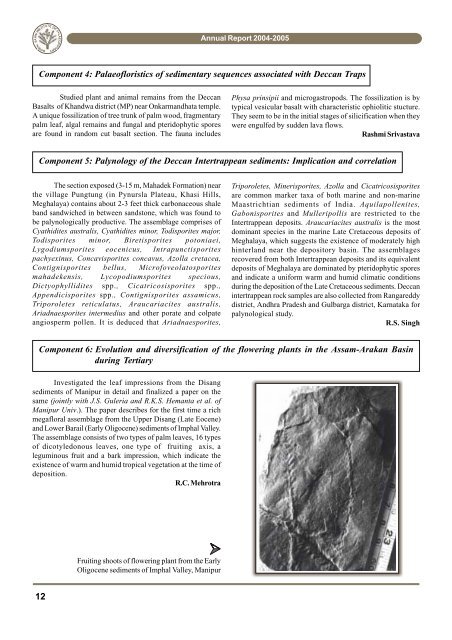english final - Birbal Sahni Institute of Palaeobotany
english final - Birbal Sahni Institute of Palaeobotany
english final - Birbal Sahni Institute of Palaeobotany
Create successful ePaper yourself
Turn your PDF publications into a flip-book with our unique Google optimized e-Paper software.
BIRBAL SAHNI INSTITUTE OF PALAEOBOTANY<br />
Annual Report 2004-2005<br />
<strong>Birbal</strong> <strong>Sahni</strong> <strong>Institute</strong> <strong>of</strong> <strong>Palaeobotany</strong><br />
Component 4: Palae<strong>of</strong>loristics <strong>of</strong> sedimentary sequences associated with Deccan Traps<br />
Studied plant and animal remains from the Deccan<br />
Basalts <strong>of</strong> Khandwa district (MP) near Onkarmandhata temple.<br />
A unique fossilization <strong>of</strong> tree trunk <strong>of</strong> palm wood, fragmentary<br />
palm leaf, algal remains and fungal and pteridophytic spores<br />
are found in random cut basalt section. The fauna includes<br />
Physa prinsipii and microgastropods. The fossilization is by<br />
typical vesicular basalt with characteristic ophiolitic stucture.<br />
They seem to be in the initial stages <strong>of</strong> silicification when they<br />
were engulfed by sudden lava flows.<br />
Rashmi Srivastava<br />
Component 5: Palynology <strong>of</strong> the Deccan Intertrappean sediments: Implication and correlation<br />
The section exposed (3-15 m, Mahadek Formation) near<br />
the village Pungtung (in Pynursla Plateau, Khasi Hills,<br />
Meghalaya) contains about 2-3 feet thick carbonaceous shale<br />
band sandwiched in between sandstone, which was found to<br />
be palynologically productive. The assemblage comprises <strong>of</strong><br />
Cyathidites australis, Cyathidites minor, Todisporites major,<br />
Todisporites minor, Biretisporites potoniaei,<br />
Lygodiumsporites eocenicus, Intrapunctisporites<br />
pachyexinus, Concavisporites concavus, Azolla cretacea,<br />
Contignisporites bellus, Micr<strong>of</strong>oveolatosporites<br />
mahadekensis, Lycopodiumsporites specious,<br />
Dictyophyllidites spp., Cicatricosisporites spp.,<br />
Appendicisporites spp., Contignisporites assamicus,<br />
Triporoletes reticulatus, Araucariacites australis,<br />
Ariadnaesporites intermedius and other porate and colpate<br />
angiosperm pollen. It is deduced that Ariadnaesporites,<br />
Triporoletes, Minerisporites, Azolla and Cicatricosisporites<br />
are common marker taxa <strong>of</strong> both marine and non-marine<br />
Maastrichtian sediments <strong>of</strong> India. Aquilapollenites,<br />
Gabonisporites and Mulleripollis are restricted to the<br />
Intertrappean deposits. Araucariacites australis is the most<br />
dominant species in the marine Late Cretaceous deposits <strong>of</strong><br />
Meghalaya, which suggests the existence <strong>of</strong> moderately high<br />
hinterland near the depository basin. The assemblages<br />
recovered from both Intertrappean deposits and its equivalent<br />
deposits <strong>of</strong> Meghalaya are dominated by pteridophytic spores<br />
and indicate a uniform warm and humid climatic conditions<br />
during the deposition <strong>of</strong> the Late Cretaceous sediments. Deccan<br />
intertrappean rock samples are also collected from Rangareddy<br />
district, Andhra Pradesh and Gulbarga district, Karnataka for<br />
palynological study.<br />
R.S. Singh<br />
Component 6: Evolution and diversification <strong>of</strong> the flowering plants in the Assam-Arakan Basin<br />
during Tertiary<br />
Investigated the leaf impressions from the Disang<br />
sediments <strong>of</strong> Manipur in detail and <strong>final</strong>ized a paper on the<br />
same (jointly with J.S. Guleria and R.K.S. Hemanta et al. <strong>of</strong><br />
Manipur Univ.). The paper describes for the first time a rich<br />
megafloral assemblage from the Upper Disang (Late Eocene)<br />
and Lower Barail (Early Oligocene) sediments <strong>of</strong> Imphal Valley.<br />
The assemblage consists <strong>of</strong> two types <strong>of</strong> palm leaves, 16 types<br />
<strong>of</strong> dicotyledonous leaves, one type <strong>of</strong> fruiting axis, a<br />
leguminous fruit and a bark impression, which indicate the<br />
existence <strong>of</strong> warm and humid tropical vegetation at the time <strong>of</strong><br />
deposition.<br />
R.C. Mehrotra<br />
Fruiting shoots <strong>of</strong> flowering plant from the Early<br />
Oligocene sediments <strong>of</strong> Imphal Valley, Manipur<br />
12

















